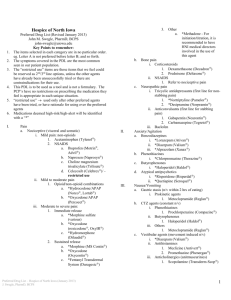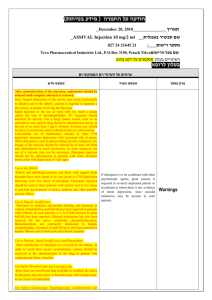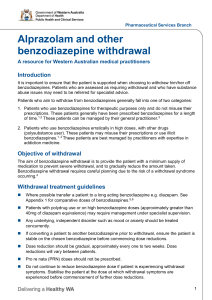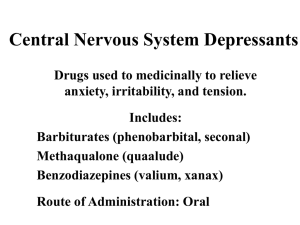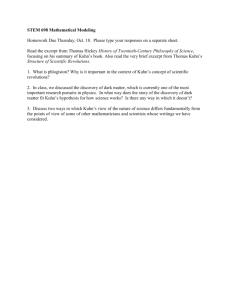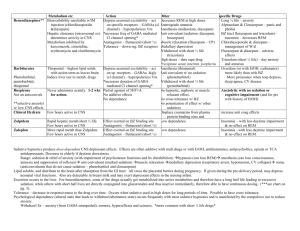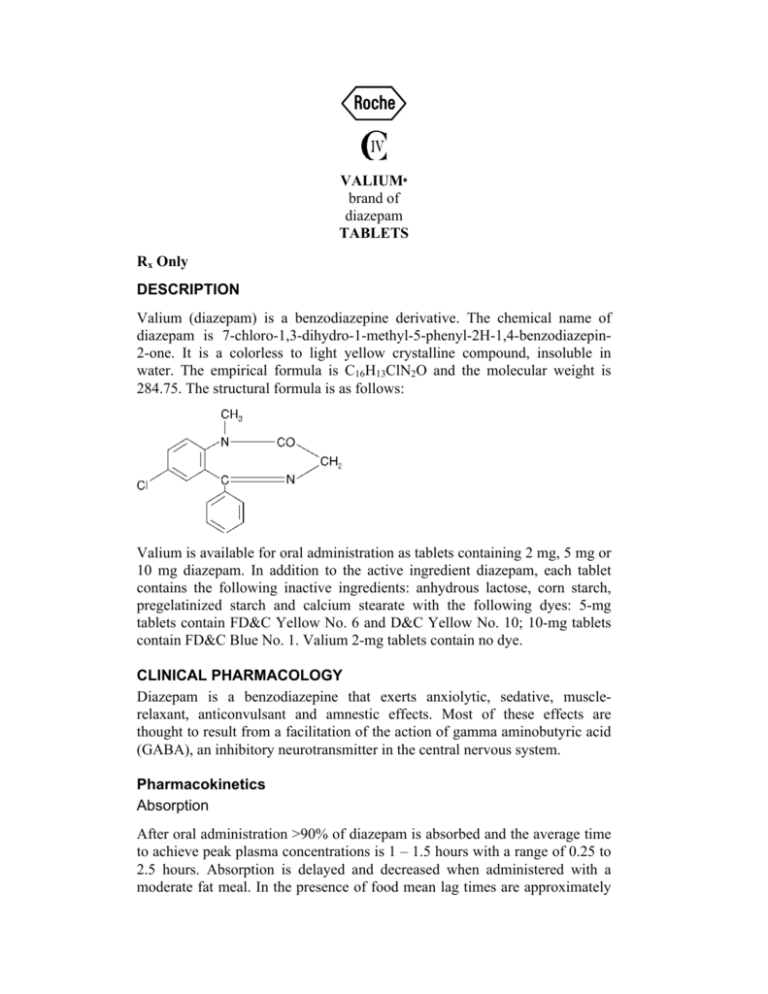
VALIUM
brand of
diazepam
TABLETS
®
Rx Only
DESCRIPTION
Valium (diazepam) is a benzodiazepine derivative. The chemical name of
diazepam is 7-chloro-1,3-dihydro-1-methyl-5-phenyl-2H-1,4-benzodiazepin2-one. It is a colorless to light yellow crystalline compound, insoluble in
water. The empirical formula is C16H13ClN2O and the molecular weight is
284.75. The structural formula is as follows:
Valium is available for oral administration as tablets containing 2 mg, 5 mg or
10 mg diazepam. In addition to the active ingredient diazepam, each tablet
contains the following inactive ingredients: anhydrous lactose, corn starch,
pregelatinized starch and calcium stearate with the following dyes: 5-mg
tablets contain FD&C Yellow No. 6 and D&C Yellow No. 10; 10-mg tablets
contain FD&C Blue No. 1. Valium 2-mg tablets contain no dye.
CLINICAL PHARMACOLOGY
Diazepam is a benzodiazepine that exerts anxiolytic, sedative, musclerelaxant, anticonvulsant and amnestic effects. Most of these effects are
thought to result from a facilitation of the action of gamma aminobutyric acid
(GABA), an inhibitory neurotransmitter in the central nervous system.
Pharmacokinetics
Absorption
After oral administration >90% of diazepam is absorbed and the average time
to achieve peak plasma concentrations is 1 – 1.5 hours with a range of 0.25 to
2.5 hours. Absorption is delayed and decreased when administered with a
moderate fat meal. In the presence of food mean lag times are approximately
45 minutes as compared with 15 minutes when fasting. There is also an
increase in the average time to achieve peak concentrations to about 2.5 hours
in the presence of food as compared with 1.25 hours when fasting. This results
in an average decrease in Cmax of 20% in addition to a 27% decrease in AUC
(range 15% to 50%) when administered with food.
Distribution
Diazepam and its metabolites are highly bound to plasma proteins (diazepam
98%). Diazepam and its metabolites cross the blood-brain and placental
barriers and are also found in breast milk in concentrations approximately one
tenth of those in maternal plasma (days 3 to 9 post-partum). In young healthy
males, the volume of distribution at steady-state is 0.8 to 1.0 L/kg. The decline
in the plasma concentration-time profile after oral administration is biphasic.
The initial distribution phase has a half-life of approximately 1 hour, although
it may range up to >3 hours.
Metabolism
Diazepam is N-demethylated by CYP3A4 and 2C19 to the active metabolite
N-desmethyldiazepam, and is hydroxylated by CYP3A4 to the active
metabolite temazepam. N-desmethyldiazepam and temazepam are both further
metabolized to oxazepam. Temazepam and oxazepam are largely eliminated
by glucuronidation.
Elimination
The initial distribution phase is followed by a prolonged terminal elimination
phase (half-life up to 48 hours). The terminal elimination half-life of the
active metabolite N-desmethyldiazepam is up to 100 hours. Diazepam and its
metabolites are excreted mainly in the urine, predominantly as their
glucuronide conjugates. The clearance of diazepam is 20 to 30 mL/min in
young adults. Diazepam accumulates upon multiple dosing and there is some
evidence that the terminal elimination half-life is slightly prolonged.
Pharmacokinetics in Special Populations
Children
In children 3 - 8 years old the mean half-life of diazepam has been reported to
be 18 hours.
Newborns
In full term infants, elimination half-lives around 30 hours have been reported,
with a longer average half-life of 54 hours reported in premature infants of 28
- 34 weeks gestational age and 8 - 81 days post-partum. In both premature and
full term infants the active metabolite desmethyldiazepam shows evidence of
continued accumulation compared to children. Longer half-lives in infants
may be due to incomplete maturation of metabolic pathways.
2
Geriatric
Elimination half-life increases by approximately 1 hour for each year of age
beginning with a half-life of 20 hours at 20 years of age. This appears to be
due to an increase in volume of distribution with age and a decrease in
clearance. Consequently, the elderly may have lower peak concentrations, and
on multiple dosing higher trough concentrations. It will also take longer to
reach steady-state. Conflicting information has been published on changes of
plasma protein binding in the elderly. Reported changes in free drug may be
due to significant decreases in plasma proteins due to causes other than simply
aging.
Hepatic Insufficiency
In mild and moderate cirrhosis, average half-life is increased. The average
increase has been variously reported from 2-fold to 5-fold, with individual
half-lives over 500 hours reported. There is also an increase in volume of
distribution, and average clearance decreases by almost half. Mean half-life is
also prolonged with hepatic fibrosis to 90 hours (range 66 - 104 hours), with
chronic active hepatitis to 60 hours (range 26 - 76 hours), and with acute viral
hepatitis to 74 hours (range 49 - 129). In chronic active hepatitis, clearance is
decreased by almost half.
INDICATIONS
Valium is indicated for the management of anxiety disorders or for the shortterm relief of the symptoms of anxiety. Anxiety or tension associated with the
stress of everyday life usually does not require treatment with an anxiolytic.
In acute alcohol withdrawal, Valium may be useful in the symptomatic relief
of acute agitation, tremor, impending or acute delirium tremens and
hallucinosis.
Valium is a useful adjunct for the relief of skeletal muscle spasm due to reflex
spasm to local pathology (such as inflammation of the muscles or joints, or
secondary to trauma), spasticity caused by upper motor neuron disorders (such
as cerebral palsy and paraplegia), athetosis, and stiff-man syndrome.
Oral Valium may be used adjunctively in convulsive disorders, although it has
not proved useful as the sole therapy.
The effectiveness of Valium in long-term use, that is, more than 4 months, has
not been assessed by systematic clinical studies. The physician should
periodically reassess the usefulness of the drug for the individual patient.
CONTRAINDICATIONS
Valium is contraindicated in patients with a known hypersensitivity to
diazepam and, because of lack of sufficient clinical experience, in pediatric
patients under 6 months of age. Valium is also contraindicated in patients with
myasthenia gravis, severe respiratory insufficiency, severe hepatic
3
insufficiency, and sleep apnea syndrome. It may be used in patients with
open-angle glaucoma who are receiving appropriate therapy, but is
contraindicated in acute narrow-angle glaucoma.
WARNINGS
Valium is not recommended in the treatment of psychotic patients and should
not be employed instead of appropriate treatment.
Since Valium has a central nervous system depressant effect, patients should
be advised against the simultaneous ingestion of alcohol and other CNSdepressant drugs during Valium therapy.
As with other agents that have anticonvulsant activity, when Valium is used as
an adjunct in treating convulsive disorders, the possibility of an increase in the
frequency and/or severity of grand mal seizures may require an increase in the
dosage of standard anticonvulsant medication. Abrupt withdrawal of Valium
in such cases may also be associated with a temporary increase in the
frequency and/or severity of seizures.
Pregnancy
An increased risk of congenital malformations and other developmental
abnormalities associated with the use of benzodiazepine drugs during
pregnancy has been suggested. There may also be non-teratogenic risks
associated with the use of benzodiazepines during pregnancy. There have
been reports of neonatal flaccidity, respiratory and feeding difficulties, and
hypothermia in children born to mothers who have been receiving
benzodiazepines late in pregnancy. In addition, children born to mothers
receiving benzodiazepines on a regular basis late in pregnancy may be at some
risk of experiencing withdrawal symptoms during the postnatal period.
Diazepam has been shown to be teratogenic in mice and hamsters when given
orally at daily doses of 100 mg/kg or greater (approximately eight times the
maximum recommended human dose [MRHD=1 mg/kg/day] or greater on a
mg/m2 basis). Cleft palate and encephalopathy are the most common and
consistently reported malformations produced in these species by
administration of high, maternally toxic doses of diazepam during
organogenesis. Rodent studies have indicated that prenatal exposure to
diazepam doses similar to those used clinically can produce long-term
changes in cellular immune responses, brain neurochemistry, and behavior.
In general, the use of diazepam in women of childbearing potential, and more
specifically during known pregnancy, should be considered only when the
clinical situation warrants the risk to the fetus. The possibility that a woman of
childbearing potential may be pregnant at the time of institution of therapy
should be considered. If this drug is used during pregnancy, or if the patient
becomes pregnant while taking this drug, the patient should be apprised of the
potential hazard to the fetus. Patients should also be advised that if they
4
become pregnant during therapy or intend to become pregnant they should
communicate with their physician about the desirability of discontinuing the
drug.
Labor and Delivery
Special care must be taken when Valium is used during labor and delivery, as
high single doses may produce irregularities in the fetal heart rate and
hypotonia, poor sucking, hypothermia, and moderate respiratory depression in
the neonates. With newborn infants it must be remembered that the enzyme
system involved in the breakdown of the drug is not yet fully developed
(especially in premature infants).
Nursing Mothers
Diazepam passes into breast milk. Breastfeeding is therefore not
recommended in patients receiving Valium.
PRECAUTIONS
General
If Valium is to be combined with other psychotropic agents or anticonvulsant
drugs, careful consideration should be given to the pharmacology of the
agents to be employed - particularly with known compounds that may
potentiate the action of diazepam, such as phenothiazines, narcotics,
barbiturates, MAO inhibitors and other antidepressants (see Drug
Interactions).
The usual precautions are indicated for severely depressed patients or those in
whom there is any evidence of latent depression or anxiety associated with
depression, particularly the recognition that suicidal tendencies may be
present and protective measures may be necessary.
Psychiatric and paradoxical reactions are known to occur when using
benzodiazepines (see ADVERSE REACTIONS). Should this occur, use of
the drug should be discontinued. These reactions are more likely to occur in
children and the elderly.
A lower dose is recommended for patients with chronic respiratory
insufficiency, due to the risk of respiratory depression.
Benzodiazepines should be used with extreme caution in patients with a
history of alcohol or drug abuse (see DRUG ABUSE AND
DEPENDENCE).
In debilitated patients, it is recommended that the dosage be limited to the
smallest effective amount to preclude the development of ataxia or
oversedation (2 mg to 2.5 mg once or twice daily, initially, to be increased
gradually as needed and tolerated).
5
Some loss of response to the effects of benzodiazepines may develop after
repeated use of Valium for a prolonged time.
Information for Patients
To assure the safe and effective use of benzodiazepines, patients should be
informed that, since benzodiazepines may produce psychological and physical
dependence, it is advisable that they consult with their physician before either
increasing the dose or abruptly discontinuing this drug. The risk of
dependence increases with duration of treatment; it is also greater in patients
with a history of alcohol or drug abuse.
Patients should be advised against the simultaneous ingestion of alcohol and
other CNS-depressant drugs during Valium therapy. As is true of most CNSacting drugs, patients receiving Valium should be cautioned against engaging
in hazardous occupations requiring complete mental alertness, such as
operating machinery or driving a motor vehicle.
Drug Interactions
Centrally Acting Agents
If Valium is to be combined with other centrally acting agents, careful
consideration should be given to the pharmacology of the agents employed
particularly with compounds that may potentiate or be potentiated by the
action
of
Valium,
such
as
phenothiazines,
antipsychotics,
anxiolytics/sedatives, hypnotics, anticonvulsants, narcotic analgesics,
anesthetics, sedative antihistamines, narcotics, barbiturates, MAO inhibitors
and other antidepressants.
Alcohol
Concomitant use with alcohol is not recommended due to enhancement of the
sedative effect.
Antacids
Diazepam peak concentrations are 30% lower when antacids are administered
concurrently. However, there is no effect on the extent of absorption. The
lower peak concentrations appear due to a slower rate of absorption, with the
time required to achieve peak concentrations on average 20 - 25 minutes
greater in the presence of antacids. However, this difference was not
statistically significant.
Compounds Which Inhibit Certain Hepatic Enzymes
There is a potentially relevant interaction between diazepam and compounds
which inhibit certain hepatic enzymes (particularly cytochrome P450 3A and
2C19). Data indicate that these compounds influence the pharmacokinetics of
diazepam and may lead to increased and prolonged sedation. At present, this
6
reaction is known to occur with cimetidine, ketoconazole, fluvoxamine,
fluoxetine, and omeprazole.
Phenytoin
There have also been reports that the metabolic elimination of phenytoin is
decreased by diazepam.
Carcinogenesis, Mutagenesis, Impairment of Fertility
In studies in which mice and rats were administered diazepam in the diet at a
dose of 75 mg/kg/day (approximately 6 and 12 times, respectively, the
maximum recommended human dose [MRHD=1 mg/kg/day] on a mg/m2
basis) for 80 and 104 weeks, respectively, an increased incidence of liver
tumors was observed in males of both species. The data currently available are
inadequate to determine the mutagenic potential of diazepam. Reproduction
studies in rats showed decreases in the number of pregnancies and in the
number of surviving offspring following administration of an oral dose of 100
mg/kg/day (approximately 16 times the MRHD on a mg/m2 basis) prior to and
during mating and throughout gestation and lactation. No adverse effects on
fertility or offspring viability were noted at a dose of 80 mg/kg/day
(approximately 13 times the MRHD on a mg/m2 basis).
Pregnancy
Category D (see WARNINGS: Pregnancy).
Pediatric Use
Safety and effectiveness in pediatric patients below the age of 6 months have
not been established.
Geriatric Use
In elderly patients, it is recommended that the dosage be limited to the
smallest effective amount to preclude the development of ataxia or
oversedation (2 mg to 2.5 mg once or twice daily, initially to be increased
gradually as needed and tolerated).
Extensive accumulation of diazepam and its major metabolite,
desmethyldiazepam, has been noted following chronic administration of
diazepam in healthy elderly male subjects. Metabolites of this drug are known
to be substantially excreted by the kidney, and the risk of toxic reactions may
be greater in patients with impaired renal function. Because elderly patients
are more likely to have decreased renal function, care should be taken in dose
selection, and it may be useful to monitor renal function.
Hepatic Insufficiency
Decreases in clearance and protein binding, and increases in volume of
distribution and half-life have been reported in patients with cirrhosis. In such
7
patients, a 2- to 5- fold increase in mean half-life has been reported. Delayed
elimination has also been reported for the active metabolite
desmethyldiazepam. Benzodiazepines are commonly implicated in hepatic
encephalopathy. Increases in half-life have also been reported in hepatic
fibrosis and in both acute and chronic hepatitis (see CLINICAL
PHARMACOLOGY: Pharmacokinetics in Special Populations: Hepatic
Insufficiency).
ADVERSE REACTIONS
Side effects most commonly reported were drowsiness, fatigue, muscle
weakness, and ataxia. The following have also been reported:
Central Nervous System: confusion, depression, dysarthria, headache, slurred
speech, tremor, vertigo
Gastrointestinal System: constipation, nausea, gastrointestinal disturbances
Special Senses: blurred vision, diplopia, dizziness
Cardiovascular System: hypotension
Psychiatric and Paradoxical Reactions: stimulation, restlessness, acute
hyperexcited states, anxiety, agitation, aggressiveness, irritability, rage,
hallucinations, psychoses, delusions, increased muscle spasticity, insomnia,
sleep disturbances, and nightmares. Inappropriate behavior and other adverse
behavioral effects have been reported when using benzodiazepines. Should
these occur, use of the drug should be discontinued. They are more likely to
occur in children and in the elderly.
Urogenital System: incontinence, changes in libido, urinary retention
Skin and Appendages: skin reactions
Laboratories: elevated transaminases and alkaline phosphatase
Other: changes in salivation, including dry mouth, hypersalivation
Antegrade amnesia may occur using therapeutic dosages, the risk increasing at
higher dosages. Amnestic effects may be associated with inappropriate
behavior.
Minor changes in EEG patterns, usually low-voltage fast activity, have been
observed in patients during and after Valium therapy and are of no known
significance.
Because of isolated reports of neutropenia and jaundice, periodic blood counts
and liver function tests are advisable during long-term therapy.
8
Postmarketing Experience:
Injury, Poisoning and Procedural Complications: There have been reports
of falls and fractures in benzodiazepine users. The risk is increased in those
taking concomitant sedatives (including alcohol), and in the elderly.
DRUG ABUSE AND DEPENDENCE
Diazepam is subject to Schedule IV control under the Controlled Substances
Act of 1970. Abuse and dependence of benzodiazepines have been reported.
Addiction-prone individuals (such as drug addicts or alcoholics) should be
under careful surveillance when receiving diazepam or other psychotropic
agents because of the predisposition of such patients to habituation and
dependence. Once physical dependence to benzodiazepines has developed,
termination of treatment will be accompanied by withdrawal symptoms. The
risk is more pronounced in patients on long-term therapy.
Withdrawal symptoms, similar in character to those noted with barbiturates
and alcohol have occurred following abrupt discontinuance of diazepam.
These withdrawal symptoms may consist of tremor, abdominal and muscle
cramps, vomiting, sweating, headache, muscle pain, extreme anxiety, tension,
restlessness, confusion and irritability. In severe cases, the following
symptoms may occur: derealization, depersonalization, hyperacusis,
numbness and tingling of the extremities, hypersensitivity to light, noise and
physical contact, hallucinations or epileptic seizures. The more severe
withdrawal symptoms have usually been limited to those patients who had
received excessive doses over an extended period of time. Generally milder
withdrawal symptoms (e.g., dysphoria and insomnia) have been reported
following abrupt discontinuance of benzodiazepines taken continuously at
therapeutic levels for several months. Consequently, after extended therapy,
abrupt discontinuation should generally be avoided and a gradual dosage
tapering schedule followed.
Chronic use (even at therapeutic doses) may lead to the development of
physical dependence: discontinuation of the therapy may result in withdrawal
or rebound phenomena.
Rebound Anxiety: A transient syndrome whereby the symptoms that led to
treatment with Valium recur in an enhanced form. This may occur upon
discontinuation of treatment. It may be accompanied by other reactions
including mood changes, anxiety, and restlessness.
Since the risk of withdrawal phenomena and rebound phenomena is greater
after abrupt discontinuation of treatment, it is recommended that the dosage be
decreased gradually.
OVERDOSAGE
Overdose of benzodiazepines is usually manifested by central nervous system
depression ranging from drowsiness to coma. In mild cases, symptoms include
9
drowsiness, confusion, and lethargy. In more serious cases, symptoms may
include ataxia, diminished reflexes, hypotonia, hypotension, respiratory
depression, coma (rarely), and death (very rarely). Overdose of
benzodiazepines in combination with other CNS depressants (including
alcohol) may be fatal and should be closely monitored.
Management of Overdosage
Following overdose with oral benzodiazepines, general supportive measures
should be employed including the monitoring of respiration, pulse, and blood
pressure. Vomiting should be induced (within 1 hour) if the patient is
conscious. Gastric lavage should be undertaken with the airway protected if
the patient is unconscious. Intravenous fluids should be administered. If there
is no advantage in emptying the stomach, activated charcoal should be given
to reduce absorption. Special attention should be paid to respiratory and
cardiac function in intensive care. General supportive measures should be
employed, along with intravenous fluids, and an adequate airway maintained.
Should hypotension develop, treatment may include intravenous fluid therapy,
repositioning, judicious use of vasopressors appropriate to the clinical
situation, if indicated, and other appropriate countermeasures. Dialysis is of
limited value.
As with the management of intentional overdosage with any drug, it should be
considered that multiple agents may have been ingested.
Flumazenil, a specific benzodiazepine-receptor antagonist, is indicated for the
complete or partial reversal of the sedative effects of benzodiazepines and
may be used in situations when an overdose with a benzodiazepine is known
or suspected. Prior to the administration of flumazenil, necessary measures
should be instituted to secure airway, ventilation and intravenous access.
Flumazenil is intended as an adjunct to, not as a substitute for, proper
management of benzodiazepine overdose. Patients treated with flumazenil
should be monitored for resedation, respiratory depression and other residual
benzodiazepine effects for an appropriate period after treatment. The
prescriber should be aware of a risk of seizure in association with
flumazenil treatment, particularly in long-term benzodiazepine users and
in cyclic antidepressant overdose. Caution should be observed in the use of
flumazenil in epileptic patients treated with benzodiazepines. The complete
flumazenil
package
insert,
including
CONTRAINDICATIONS,
WARNINGS, and PRECAUTIONS, should be consulted prior to use.
Withdrawal symptoms of the barbiturate type have occurred after the
discontinuation of benzodiazepines (see DRUG ABUSE AND
DEPENDENCE).
DOSAGE AND ADMINISTRATION
Dosage should be individualized for maximum beneficial effect. While the
usual daily dosages given below will meet the needs of most patients, there
10
will be some who may require higher doses. In such cases dosage should be
increased cautiously to avoid adverse effects.
ADULTS:
USUAL DAILY DOSE:
Management of Anxiety Disorders and Relief Depending upon severity of symptoms—2 mg
of Symptoms of Anxiety.
to 10 mg, 2 to 4 times daily
Symptomatic
Withdrawal.
Relief
in
Acute
Alcohol 10 mg, 3 or 4 times during the first 24 hours,
reducing to 5 mg, 3 or 4 times daily as needed
Adjunctively for Relief of Skeletal Muscle 2 mg to 10 mg, 3 or 4 times daily
Spasm.
Adjunctively in Convulsive Disorders.
2 mg to 10 mg, 2 to 4 times daily
Geriatric Patients, or in the presence of 2 mg to 2.5 mg, 1 or 2 times daily initially;
debilitating disease.
increase gradually as needed and tolerated
PEDIATRIC PATIENTS:
Because of varied responses to CNS-acting 1 mg to 2.5 mg, 3 or 4 times daily initially;
drugs, initiate therapy with lowest dose and increase gradually as needed and tolerated
increase as required. Not for use in pediatric
patients under 6 months.
HOW SUPPLIED
For oral administration, Valium is supplied as round, flat-faced scored tablets
with V-shaped perforation and beveled edges. Valium is available as follows:
2 mg, white - bottles of 100 (NDC 0140-0004-01); 5 mg, yellow - bottles of
100 (NDC 0140-0005-01) and 500 (NDC 0140-0005-14); 10 mg, blue bottles of 100 (NDC 0140-0006-01) and 500 (NDC 0140-0006-14).
Engraved on tablets:
2 mg—2 VALIUM® (front)
ROCHE (twice on scored side)
5 mg—5 VALIUM® (front)
ROCHE (twice on scored side)
10 mg—10 VALIUM® (front)
ROCHE (twice on scored side)
STORAGE
Store at room temperature 59º to 86ºF (15º to 30ºC). Dispense in tight, lightresistant containers as defined in USP/NF.
11
VALIUM
is
a
registered
trademark
of
Hoffmann-La
Roche,
Inc.
Revised: August 2015
© 2015 Genentech, Inc. All rights reserved.
12

